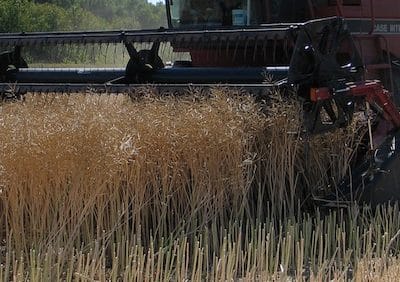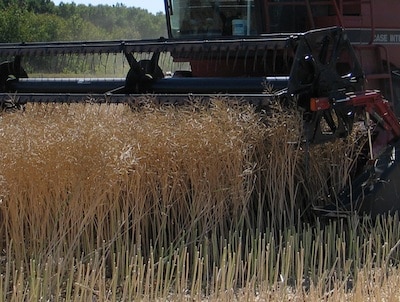Growers straight combining canola for the first time may want to consider these tips:
—Practice on a couple fields. Growers who successfully straight combine say that experience leads to success. If straight combining for the first time, try a small number of acres, to experiment with timing and technique.
—Choose suitable fields. Fields that make good candidates for straight cutting are those with heavy crop canopies that are well knitted to prevent whipping and shattering in the wind. You also want to ensure that there is good pod integrity (i.e. little disease or physical damage) to limit shattering losses.
—Be prepared to harvest as soon as green seed and seed moisture drop to acceptable levels, even if stalks are still green. This may take more power for combining but will limit opportunity for shattering losses prior to harvesting. It may also mean additional conditioning is required for storage, so ensure adequate aeration and/or drying capacity is available.
—Have the cutterbar in front of the reel. Set the reel as far back as possible, as long as it still allows for smooth feeding of the combine. That way, when the reel hits the canola, any pods that break open will drop their seeds on to the platform, not onto the ground. The longer the distance between the cutterbar and header auger, the better to reduce losses.
—Set reel speed equal to ground speed of the combine. This reduces contact with the pods.
—Avoid combining during hot dry days if the pods are brittle. Cooler days or mornings and evenings with a bit of dew are preferable to reduce pod shatter on impact, but this can present a challenge to combine efficiency if the stems are somewhat green. Depending on seed moisture levels, this may also mean additional conditioning for safe storage.
—Work around low spots with later green seeds and higher weed biomass. These will slow you down and green plant material in the sample could increase the spoilage risk. Swath these areas and combine them later.
—The point of no return. Once the decision to straight cut is made and crops are allowed to ripen standing, shattering losses will be high if the decision to swath is then made late (beyond 70 to 80% seed colour change). If a field that mature must be swathed, it must be done in very moist conditions (rain or heavy dew) to limit shattering as much as possible. The final decision on whether to swath or straight cut really needs to be made prior to the optimal swathing stage (up to 60% SCC).
—Pod sealant. Recent western Canadian research at a limited number of trial locations has to date not indicated significant benefits overall, but some individual trials and producer experiences have occasionally been positive. Read more.


